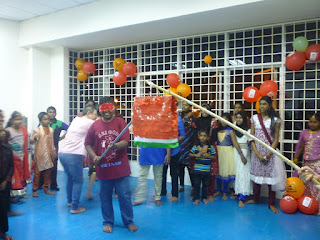PENCINTA
ALAM JANUARY 2016
ECO
KIDS COLUMN
QUICK
AND EASY WATERMELON PINATA
By
Wong Ee Lynn
The
New Year has just begun, and that means a whole year’s worth of parties and
celebrations lies ahead of us!
Piñatas
are treat-filled papier-mâché or clay shells believed to originate from Europe,
but are often associated with Mexico. They were made immensely popular by the
USA, and have now become a common sight around the world, including in
Malaysia, where children wait eagerly for their turn to strike at and break
piñatas at parties.
Piñatas
can be expensive to buy, and time-consuming to make.
Here is a quick and easy version
of a homemade piñata that uses paper bags and other items found around the
home, and wastes far less paper than the traditional cardboard and papier-mâché
ones.
THINGS
YOU NEED:
1.
A
large, sturdy paper bag. You may need to make a few strategic slits in the bag
to make it break more easily so that your party guests will not be kept
slugging away at the indestructible piñata for hours, like ours had to.
2.
Crepe
paper or coloured paper in different colours. We used red, white and green
crepe paper left over from another art project, as we wanted to create a
watermelon piñata.
3.
A
scrap of black construction paper.
4.
Adhesive
tape.
5.
Scissors.
6.
Instead
of cheap, junky plastic piñata fillers, stuff it with things your guests can
use.
We filled ours with card games, stickers, erasers, pencils, small comic/picture books, sweets, boxes of raisins and packets of roasted seeds and nuts.
We filled ours with card games, stickers, erasers, pencils, small comic/picture books, sweets, boxes of raisins and packets of roasted seeds and nuts.
Step 1: While the
crepe paper is still folded, cut it into strips. We used a ruler to draw lines
on ours to ensure that they are all of uniform width.
Step 2: Cut slits into
each strip of folded crepe paper, but do not cut all the way through or you
will end up with a pile of little squares that will take you weeks to stick
onto your piñata. Make it look like the teeth of a comb – the long ‘spine’
still holds all the ‘teeth’ together.
Step 3: Unfold /
unravel the crepe paper strips very, very slowly and carefully, as it will tear
easily. Don’t worry, you will get better at it with each strip. Use adhesive
tape to stick the strips of the crepe paper to the paper bag. Adhesive tape
sticks to the surface of paper bags better than glue. Also, you will not have
to wait for glue to dry. Start from the bottom of the bag, and stick each strip
of crepe paper slightly overlapping the previous strip. Think of how roof
tiles/shingles are laid – Each row slightly overlaps the row beneath it.
Step 4: We taped 3
rows of green paper to the lowest part of the bag to form the watermelon ‘outer
skin’, one row of white paper as the ‘rind’, and covered the rest in red so
that it would resemble a ripe, juicy, rectangular slice of watermelon. Cover
the entire piñata in crepe paper strips, including the bottom. Fill up any gaps
with smaller strips of crepe paper to hide the paper bag.
Step 5: Cut out a
bunch of tear-shaped watermelon ‘seeds’ out of black construction paper. Use
adhesive tape to stick these ‘seeds’ to the slice of watermelon in a
semi-circle or curve, just as you see in watermelons in real life.
Step 6: Fill up the
paper bag and seal the mouth of the paper bag. The handles of the paper bag can
be tied around a long pole (if the piñata is to be held by one or two persons)
or suspended from a string from the ceiling or a tree branch.
There are so many
designs you can create with a cuboid paper bag. It doesn’t have to be a
watermelon slice. You can make it your favourite colour and add your initials
in a contrasting colour. You can make a rainbow piñata, a flag piñata, a stripy
piñata, a patchwork quilt of scrap coloured paper, or an ombre piñata in your
favourite colour starting with the lightest shade to the darkest. You could try
covering your piñata in blue crepe paper ruffles and add fish and marine
creatures cut out of bright-coloured construction paper, or cover it in black
paper and add stars and planets and rockets. Or you might want to turn it into
a big, silver cuboid robot.
If you wish to go the
extra mile in not wasting paper and resources, you could collect a bunch of old
catalogues and magazines and cut out the coloured portions and sort them into
piles according to colour before pasting them on your piñata.
If you are filling a
piñata for adults or for a mixed family crowd, you could add eco-friendly gifts
such as reusable shopping bags and cotton handkerchiefs and fun things such as
brain teasers, mini puzzles, decks of cards, coins, snacks and leftover
travel/event souvenirs such as key chains, stress balls and mobile phone
pouches. Do NOT add anything liquid, such as small bottles of body wash,
perfume or soap bubble solution, or pudding and jelly cups, as the bottles or
cups may break when hit and the liquid will soak all the other piñata contents.
If you are adding snacks and sweets, do not add soap, candles or anything
strongly-scented, or your guests may end up with chips and sweets that smell
and taste of soap.
Remember to provide
your guests with used envelopes or paper bags to store their piñata loot in. We
forgot to provide our guests with bags and they carried their goodies home in
their pockets and inside their shirts.
Use your imagination
and find ways to throw a great party without generating too much waste!













